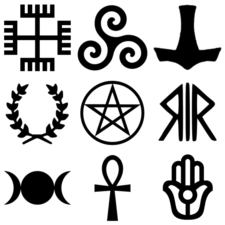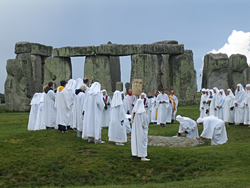- List of Neopagan movements
-
Neopaganism, or contemporary paganism, encompasses a wide range of religious groups and individuals. These may include old occult groups, those that follow a New Age approach, those that try to reconstruct old ethnic faiths, and followers of the religion of Wicca. For organizations, the founding year is given in brackets.
Contents
Early movements
Pre-World War II Neopagan or proto-Neopagan groups, growing out of occultism and/or Romanticism (Viking revival, Celtic revival).
- Druidism
- The Druid Order (1717)
- Ancient Order of Druids (1781)
- Germanic Neopaganism / Armanism
- Germanische Glaubens-Gemeinschaft (1907)
- Guido von List Society (1908)
- Hermetic Order of the Golden Dawn (1888)
- Church of the Universal Bond (1912)
- Crowleyan Thelema (1930s)
- Adonism (1925)
Witchcraft
Main articles: Wicca and Contemporary witchcraftSee also: Category: Wiccan traditionsWicca originated in 1940s Britain and became the mainstream of Neopaganism in the United States in the 1970s. There are two core traditions of Wicca which originated in Britain, Gardnerian and Alexandrian, which are sometimes referred to as British Traditional Wicca. From these two arose several other variant traditions. Wicca has also inspired a great number of other witchcraft traditions in Britain, Europe and the United States, most of which base their beliefs and practices on Wicca. Many movements are influenced by the Movement of the Goddess, and New Age and feminist worldviews.
Wicca
 A Wiccan ritual altar.
A Wiccan ritual altar.
- British Traditional Wicca
- Gardnerian Wicca (1948)
- Alexandrian Wicca (1967)
- Algard Wicca
- Central Valley Wicca
- Chthonioi Alexandrian Wicca
- Blue Star Wicca
- Eclectic Wicca and Inclusive Wicca
- Celtic Wicca
- Saxon Wicca
- Dianic Wicca
- McFarland Dianic Wicca
- Faery Wicca
- Correllian Nativist Tradition
- Georgian Wicca
- Odyssean Wicca
- Wiccan Churches
- New Reformed Orthodox Order of the Golden Dawn (1968)
- Church and School of Wicca (1968)
- Circle Sanctuary (1974)
- Covenant of the Goddess (1975)
- Aquarian Tabernacle Church (1979)
- Rowan Tree Church (1979)
- Covenant of Unitarian Universalist Pagans (1985)
- Coven of the Far Flung Net (1998)
Other
- Stregheria (Aradianism)
- Hedge Witchcraft
- Cochrane's Craft
- Children of Artemis
New Age, Eclectic or Syncretic
- Feri Tradition
- Reclaiming
- Feraferia
- Church of All Worlds
- Westernesste
Ethnic
Further information: Polytheistic reconstructionismHeathenism (Germanic)
Main article: Germanic NeopaganismHeathenism (also Heathenry), or Greater Heathenry, is a blanket term for the whole Germanic Neopagan movement. Various currents and denominations have arisen over the years within it, including recently a grassroots movement of local independent Kindreds.
- Forn Siðr: Ásatrú or Vanatrú (Norse Paganism)
- Íslenska Ásatrúarfélagið (1972)
- Ring of Troth (1987)
- Asatru Folk Assembly (1996)
- Swedish Asatru Assembly (1994)
- Åsatrufellesskapet Bifrost (1996)
- International Asatru-Odinic Alliance (1997–2002)
- Broederskap van Gar / Brotherhood of Gar (see Hendrik Spoorbek)
- Folktrú (folklorist Scandinavian Forn Siðr)
- Foreningen Forn Sed (1999)
- Samfälligheten för Nordisk Sed (1999)
- Odinism or Wotanism (Folkish movements)
- Odinic Rite (1973)
- Odinist Fellowship (1996)
- The Odin Brotherhood (no date)
- Theodism (American tribalist movements)
- Armanism or Irminism (or Irminenschaft) (German Paganism and Ariosophical movements)
- Heidnische Gemeinschaft (1985)
- Artgemeinschaft (1951)
- Deutsche Heidnische Front (1998)
- New Armanen-Orden
- Urglaawe (Pennsylvanian Deitsch Paganism)
Celtism (Celtic)
Main article: Celtic Neopaganism- Celtic Reconstructionism (1980s)
- Druidism or Druidry, or Neodruidism or Neodruidry
- Reformed Druids of North America (1963)
- Order of Bards, Ovates and Druids (1964)
- British Druid Order (1979)
- Ár nDraíocht Féin (1983)
Other European
 Ritual at the Temple of Garni, in Armenia.
Ritual at the Temple of Garni, in Armenia.
- Hellenic Neopaganism (Hellenism)
- Supreme Council of Ethnikoi Hellenes (established 1997)
- Hellenion (2002)
- Roman Way to the Gods or Religio Romana
- Armenian Neopaganism (Hetanism)
- Slavic Neopaganism (Rodnovery)
- RUNVira, Sylenkoism (1966)
- Native Polish Church (1995)
- Native Faith Association of Ukraine (1998)
- Baltic Neopaganism
- Finnish Neopaganism (Suomenism)
- Taaraism and Maausk (Estonian Neopaganism)
- Maavalla Koda
- Church of the Guanche People (Guanche religion)
Ancient Near East
- Semitic Neopaganism
- Jewitchery (syncretic Jewish-Wiccan)
- Kemetism (Egyptian Neopaganism)
- Ausar Auset, "Black" Kemetism or Neterianism (1973)
- Kemetic Orthodoxy, "White" Kemetism (1988)
- Church of the Eternal Source (1970)
- Ta Noutri (2002)
Similar non-Pagan (non-European or Near Eastern) movements
- Candomblé (Afro-Brazilian religion)
- Maria Lionza religion (Venezuela)
- Vodun religions (African and African-American)
See also
External links
Contemporary Paganism Movements SyncreticAdonism · Christianity · Church of All Worlds · Church of Aphrodite · Feraferia · Neo-Druidism · Neoshamanism · Neo-völkisch movements · Technopaganism · Thelema · Unitarian Universalist · WiccaEthnicApproaches By region German-speaking Europe · Greece · Hungary · Ireland · Latin Europe · Scandinavia · Slavic Europe · UK · USARelated Categories:- Neopagan traditions
- Pagan religious organizations
- Religion-related lists
- Druidism
Wikimedia Foundation. 2010.



